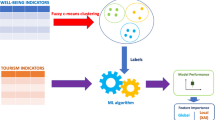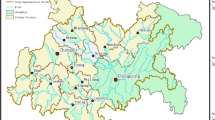Abstract
In order to study the spatial and temporal distribution of visitor flow in the construction of tourism culture, this article first studies and analyzes the space-time behavior of tourists, and divides the environment of the scenic spot into three parts: entrance, exit, and stop. Then, based on the three parts, the time and space distribution data of tourists are collected from five aspects: the arrival probability distribution of tourists, the probability of transition between tourist attractions, the distribution of attraction time, the moving time between attractions, and the area of scenic spots. The number of visitors in each attraction, and by fitting the curve, the probability distribution of the tourist time of each attraction is obtained. Finally, a neural network–based prediction model of the space-time distribution of tourists is established. The collected data is brought into the neural network. By comparing the predicted values with the actual values, the model has high prediction accuracy and can be used to predict the spatial and temporal distribution of tourists.










Similar content being viewed by others
References
Zhang ZZ (2016) Study on spatial and temporal behavior of tourists in Huashan scenic spot based on multi-source data [D]. Shaanxi Normal University
Zhang SJ (2015) Study on the spatiotemporal behavior of tourists in Daxi Tourist Circle based on geographical marker photos [D]. Shaanxi Normal University
Liang YJ (2018) Study on spatio-temporal behavior characteristics of tourists based on tourism digital footprint [D]. Zhejiang University of Industry and Commerce
Florescu L, Parpală L, Dumitrache A et al (2013) Spatial and temporal distribution of the zooplankton biomass in Sfântu Gheorghe branch (the Danube Delta, Romania) in relation to environmental factors[J]. Travaux du Muséum National d’Histoire Naturelle “Grigore Antipa” 56(1):109–124
Herbut P, Angrecka S, Nawalany G et al (2015) Spatial and temporal distribution of temperature, relative humidity and air velocity in a parallel milking parlour during summer period[J]. Ann Anim Sci 15(2):517–526
Sun YY, Chen HF (2018) Study on the spatio-temporal characteristics of tourist experience in imperial mausoleum based on emotional analysis: taking the Museum of Terracotta Warriors and Horses of Qinshihuang as an example [J]. Journal of Xianyang Normal University 33(06):12–18
Xu XY, long Tao (2018) Spatial and temporal distribution characteristics of overseas tourists’ interest points (POI) in Shanghai central city, [J]. World Regional Studies 27(05):147–156
Collie (2018) Study on the spatio-temporal behavior of tourists in cultural heritage sites based on digital footprint --- taking Pingyao Ancient City as an example [J]. Journal of Xi’an University (Natural Science Edition) 21(05):100–103
Wang L, Wang CQ (2018) Sun Mengyang. Study on the influence of cultural distance on spatial and temporal behavior of Beijing inbound tourists [J]. Hum Geogr 33(04):137–145
Galí N, Aulet S (2019) Tourists’ space–time behavior in heritage places: comparing guided and nonguided visitors[J]. Int J Tour Res 21(3):388–399
Meng Y, Li G, Lin W, Gilmore JH, Shen D (2014) Spatial distribution and longitudinal development of deep cortical sulcal landmarks in infants[J]. Neuroimage 100:206–218
Nakayasu A, Namba T (2018) Stability properties and large time behavior of viscosity solutions of Hamilton–Jacobi equations on metric spaces [J]. Nonlinearity 31(11):5147
Li N (2018) Spatial-temporal distribution characteristics of visitors to Hunan Forest Park based on micro-blog check-in [D]. Central South University of Forestry Science and Technology
Akdeniz E, Egrioglu E, Bas E et al (2018) An ARMA type Pi-Sigma artificial neural network for nonlinear time series forecasting [J]. Journal of Artificial Intelligence and Soft Computing Research 8(2):121–132
Guo YT (2018) Study on spatio-temporal behavior of domestic tourists in Shanghai based on tourist digital footprint [D]. Shanghai Normal University
Zhang M (2018) A study on the impact of tourist behavior based on virtual tourism experience [D]. Chongqing Normal University
Li RY (2018) Study on spatial and temporal differentiation of tourist flow in Yaohu Country Forest Park, Nanchang City [D]. Jiangxi Normal University
Zhang H, Tang W, Hu Z, et al. (2014) A method for forecasting the spatial and temporal distribution of PEV charging load[C]//2014 IEEE PES General Meeting| Conference & Exposition. IEEE: 1-5.
Mo W, Tian S, Huang J, et al. (2011) Temporal-spatial distribution and first flush effect of precipitation runoff pollution in Kunming urban area after the once-in-a-century drought[C]//2011 International Conference on Electric Technology and Civil Engineering (ICETCE). IEEE, 4569-4572
Tian RF (2018) Study on spatio-temporal behavior of tourists from ASEAN countries in Guangxi [D]. Guangxi University
Shan J (2018) A study on the emotional experience of domestic tourists on Tibetan tourist routes [D]. Shaanxi Normal University
Hu MM, Zhao R, Peng G, Peiyu R (2018) Spatial-temporal distribution optimization simulation of tourist attractions based on management entropy [J]. Tourism Science 32(02):28–41 +53
Wu CT, Xiang HR (2017) Study on spatio-temporal behavior characteristics of tourists to Dalian based on geographical marker photos [J]. Journal of Liaoning Normal University (Natural Science Edition) 40(03):387–394
Jin N, Liu W, Wang J, et al. (2011) Temporal and spatial distribution characteristics of frequency and the research of a new under-frequency load shedding[C]//2011 Asia-Pacific Power and Energy Engineering Conference. IEEE, 1-5
Guo YT, Jia TF (2017) Study on spatio-temporal behavior characteristics of domestic tourists in Shanghai based on tourist digital footprint [J]. Resource Development and Market 33(09):1147–1152 +1154
Cui K, Jing X (2018) Research on prediction model of geotechnical parameters based on BP neural network [J]. Neural Comput & Applic, 1-11
Amirsadri S, Mousavirad SJ, Ebrahimpour-Komleh H (2018) A levy flight-based grey wolf optimizer combined with back-propagation algorithm for neural network training[J]. Neural Comput & Applic 30(12):3707–3720
Li J, Zhao D, Ge BF et al (2018) A link prediction method for heterogeneous networks based on BP neural network [J]. Physica A: Statistical Mechanics and its Applications 495:1–17
Cui K, Qin X (2018) Virtual reality research of the dynamic characteristics of soft soil under metro vibration loads based on BP neural networks [J]. Neural Comput & Applic 29(5):1233–1242
Yuan C, Sun X, Wu QMJ (2019) Difference co-occurrence matrix using BP neural network for fingerprint liveness detection [J]. Soft Comput 23(13):5157–5169
Li B, Li Y, Wang H et al (2018) Compensation of automatic weighing error of belt weigher based on BP neural network [J]. Measurement 129:625–632
Faris H, Aljarah I, Mirjalili S (2018) Improved monarch butterfly optimization for unconstrained global search and neural network training [J]. Appl Intell 48(2):445–464
Zhang W, Han G, Wang J et al (2019) A BP neural network prediction model based on dynamic cuckoo search optimization algorithm for industrial equipment fault prediction [J]. IEEE Access 7:11736–11746
Mohamad ET, Armaghani DJ, Momeni E et al (2018) Rock strength estimation: a PSO-based BP approach [J]. Neural Comput & Applic 30(5):1635–1646
Zhang J, Liu Z (2011) A study on the space distribution and temporal evolvement of electric power load [C]//2011 Asia-Pacific Power and Energy Engineering Conference. IEEE, 1-4
Timashev AN (2019) Limit Poisson law for the distribution of the number of components in generalized allocation scheme [J]. Discret Math Appl 29(4):255–266
Zhu B, Chen J, Chen H (2019) Performance of multiple probability distributions in generating daily precipitation for the simulation of hydrological extremes [J]. Stoch Env Res Risk A 33(8-9):1581–1592
Marinho PRD, Silva RB, Bourguignon M, Cordeiro GM, Nadarajah S (2019) AdequacyModel: an R package for probability distributions and general purpose optimization[J]. PLoS One 14(8):e0221487
Li Y, Wang L (2019) A novel noise reduction technique for underwater acoustic signals based on complete ensemble empirical mode decomposition with adaptive noise, minimum mean square variance criterion and least mean square adaptive filter [J]. Defence Technology
Huang Y (2015) Research on tourism emotional experience process based on time and space path——taking Hong Kong Ocean Park as an example [J]. Tourism Journal 30(06):39–45
Author information
Authors and Affiliations
Corresponding author
Additional information
Publisher’s note
Springer Nature remains neutral with regard to jurisdictional claims in published maps and institutional affiliations.
Rights and permissions
About this article
Cite this article
Li, X. Space-time distribution model of visitor flow in tourism culture construction via back propagation neural network model. Pers Ubiquit Comput 24, 223–235 (2020). https://doi.org/10.1007/s00779-019-01342-w
Received:
Accepted:
Published:
Issue Date:
DOI: https://doi.org/10.1007/s00779-019-01342-w




